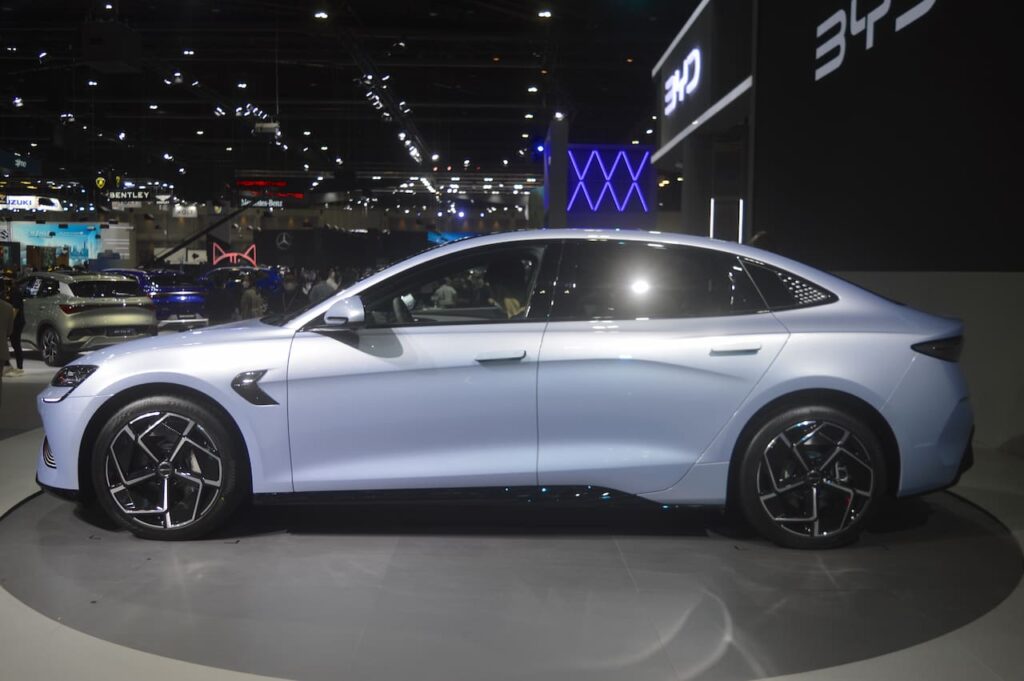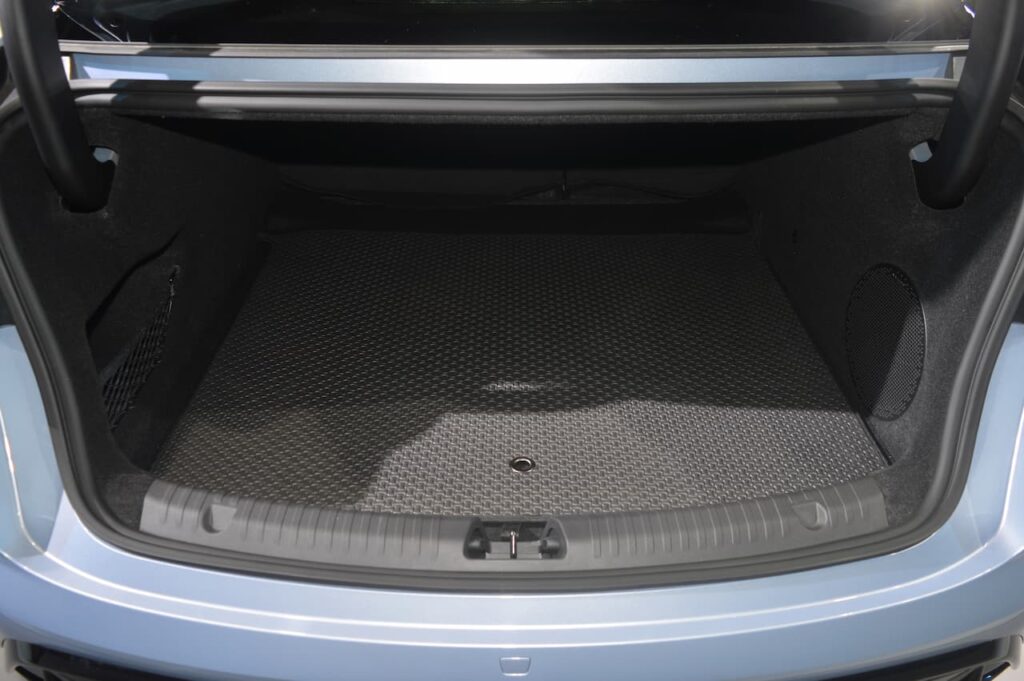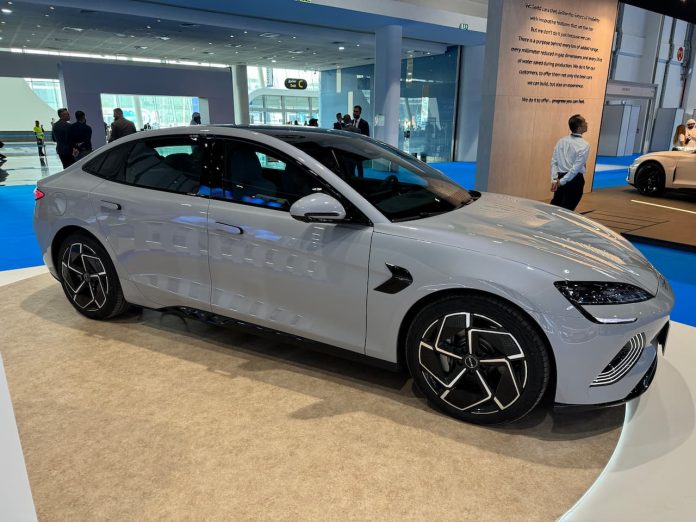The BYD Seal (BYD Atto 4 in some parts of the world) is part of the brand’s ‘Ocean’ series of future EVs. As it becomes available in new global markets, here’s our take on the Chinese electric sedan following our first-hand experience with the car in LHD and RHD specifications:
Design
The Seal may look familiar if you’ve seen the Han EV, but it wears a distinctive exterior design inspired by the BYD Ocean X concept. The most attractive design feature in daylight is the car’s athletic proportions, particularly the tight rear end.

At the front, the Seal features a low hood, slim headlamps with a Renault-style C-shaped extension below it, a smooth bumper, slanted vertical side air inlets in an artistic design, and an A-shaped compact lower air intake.
The Seal flaunts a four-door-coupe look with a sleek roofline and a bow-shaped greenhouse. Arrow-shaped applique on the front quarter panels, flush door handles, smooth sculpting on the doors, water drop-like motif on the C-pillars, and shark gill-like inserts in the rocker panels are the other noteworthy aspects of the sides.

At the rear, the new electric sedan has a full-width taillamp reminiscent of the Mercedes EQE, vertical side air outlets, a diffuser-style bumper, and separate reverse lights positioned alongside fog lights on the bumper.
Interior
Seating and comfort
The BYD Seal offers seating for five occupants with sporty seats featuring ample side bolstering in the front, and bench along with a flat floor in the back. Light blue dominates the interior, in line with the ocean theme of the model family, and the white seats feature light blue piping for a contrasting look.


The door handles are shaped like a shell, and the Alcantara usage adds to the cabin’s premium appeal. Customers can comfortably load the luggage into the boot, which has a flat floor, thanks to a low loading lip and a wide aperture.
Features
The driver’s seat is 8-way electrically adjustable and includes 4-way electrically adjustable lumbar support and memory, ventilation, and heating functions as well. The front passenger’s seat offers 6-way electric adjustment, ventilation, and heating. A dual-zone automatic climate control system with a heat pump that reuses waste heat energy to reduce energy consumption is standard. Also included in the range are a PM2.5 air filter and a panoramic sunroof with a light sensor for automatically adjusting the transparency.


The electric sedan features a minimalist interior with ocean-themed blue colors on various elements. It has a sleek dashboard with wide and curvy (outer-end) AC vents, a W-HUD, a 10.25-inch large digital instrument cluster, a wavy, bridge-type center console that houses a stubby drive selector, parking brake, two scrollers, a park assist button, and other drive controls, and NFC-based digital key. BYD-branded door sills, Qi wireless charging pad, and Dynadash audio system are other equipment highlights of the interior.
Infotainment
The Seal features a 15.6-inch tablet-style touchscreen infotainment system that tilts. The driver can change the orientation from landscape to portrait as per their preference. The 5G-enabled system includes BYD’s DiLink intelligent connected system that allows customers to install smartphone-like applications in the infotainment system.
Ingress & Egress
I’m six feet tall, and entering the vehicle was somewhat challenging due to its lower roofline and seat positioning. Inside, the seat felt comfortable with excellent support for the back and shoulders, and fair support under the thighs. It includes heating and ventilation features. Although the headrest is fixed, it still supports well. For someone of my height, the headroom was just sufficient.
Visibility & Interior appointments
Despite its coupe-like sedan design, BYD’s designers effectively maximized visibility. The steering wheel, featuring a manually adjustable column, provided a solid grip. I particularly found the blue topstitching and piano black finish on the spokes sporty.
The material quality inside was notably high-end, and I could distinguish up to five different textures on the door panel. However, the abundant piano black finish on the center console attracted fingerprints easily and could benefit from an update in future models. During my experience, I enjoyed the crystal gear selector and glass roof, which added both style and functionality.
Rear seat comfort

In the back seat, positioned directly behind a setting for a six-foot driver, I found the legroom sufficient and the knee space comfortable. The backrest angle felt ideal, although there’s no option to recline. The seat folds for loading longer items. The under-thigh support was moderate, and the headroom was just adequate. Passengers taller than six feet will prefer the front seats.
Specifications
Platform
Underpinning the Seal is the bespoke BYD e-Platform 3.0, which supports RWD (like in the case of this sedan) and AWD electric drivetrain layouts. The new BYD EV has a double-wishbone suspension at the front and a five-link independent suspension at the rear. Though smaller than the Han EV, it has the same wheelbase, thanks to the dedicated EV platform. Customers will get a comparable room in a smaller footprint, and the smaller dimensions would help in maneuverability and parking.
Battery
The Seal is BYD’s first model to feature CTB (cell-to-body) battery technology, which integrates the battery into the vehicle’s structure, applying the ‘sandwich’ construction technique in the vehicle. The top cover of the battery pack is integrated into the floor of the vehicle’s body. CTB has led to a 100% increase in torsional stiffness (compared to conventional designs) – 40,000+ Nm/°.
The CTB layout raises the chassis height, reducing the car’s susceptibility to damage from bumps. Plus, the volume utilization is better – 66%. Lastly, in case of a side collision, the higher stiffness should protect the car more.

iTAC
The Seal is BYD’s first car to feature its new iTAC technology. Short for “intelligence Torque Adaption Control,” the system aims to offer more traction than a conventional stability control system that uses wheel sensors to monitor speed changes and brakes to intervene when needed.
| Aspect\Specification | Base Variant | Mid-level Variant | Top-end Variant |
| Length/Width/Height | 4,800 mm/1,875 mm/1,460 mm | 4,800 mm/1,875 mm/1,460 mm | 4,800 mm/1,875 mm/1,460 mm |
| Wheelbase | 2,920 mm | 2,920 mm | 2,920 mm |
| Tires | 225/50 R18 | 235/45 R19 | 235/45R19 |
| Drivetrain Layout | RWD | RWD | AWD |
| No. of Motor(s) | One | One | Two |
| System Power | 150 kW (201 hp) | 230 kW (308 hp) | 390 kW (523 hp) |
| System Torque | 310 Nm (229 lb.-ft.) | 360 Nm (266 lb.-ft.) | 670 Nm (494 lb.-ft.) |
| 0-100 km/h (0-62 mph) Acceleration Time | 7.5 seconds | 5.9 seconds | 3.8 seconds |
| Battery Pack Capacity | 61.4 kWh | 82.5 kWh | 82.5 kWh |
| Range (CLTC) | 550 km (342 miles) | 700 km (435 miles) | 650 km (404 miles) |
| AC Charging Power | 7 kW | 7 kW | 7 kW |
| DC Charging Power | 110 kW | 150 kW | 150 kW |
| 30-80% DC Charging Time | 30 minutes | 30 minutes | 30 minutes |
First impressions
Those who’ve tested the car would also attest that the mid-level variant, which is focused on maximizing range, offers superb acceleration. It starts off with much gusto, and maintains that till it hits the three-digit figure. The braking performance is surprisingly good, and the car offers an impressively quiet cabin. The steering is responsive and well-weighted, though this is not a machine built for the race track! The suspension is on the firmer side, but a jarring is not felt in the cabin while driving on rough patches.
TopElectricSUV says


China, a front-runner in EV technology, has another exciting product that is relevant to car buyers in many parts of the world. The Seal mid-size sedan offers solid performance and a long range, making it perfect for anxiety-free road trips. Plus, it has plenty of high-tech features and a sporty design that will appeal to buyers of different age groups.
BYD Seal/Atto 4 FAQs
What is the BYD Seal’s price?
The Seal is priced starting at GBP 45,695 OTR in the UK.
Which EVs are the BYD Seal’s rivals?

An automobile engineer by training, I’ve analyzed the global car market since 2005, with a keen focus on EVs since 2008. My journey in online automotive publishing spans 16 years, during which I have reviewed cutting-edge automotive technologies and interviewed leading CEOs and vehicle developers from around the world.









